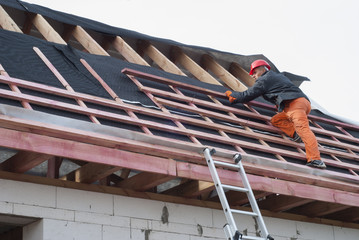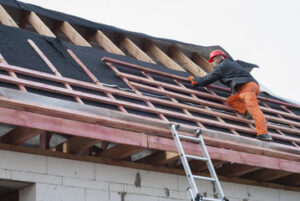Your roof is a vital part of your home. If it’s not in tip-top condition, the rest of your house will suffer. Surface damage, such as shingle repair or replacing a few missing ones, is relatively inexpensive. Repairing a leak is more expensive. The type of repair from the Stonemark company is also important. For example, modern roofs use rubber or tar around some vent and pipe openings. These tend to degrade over time and leak water into areas where you don’t want it to go.
Damaged Shingles

Your roof protects your home 24/7, so it’s important to keep it in good condition. If you notice water leaking into your home or a musty smell in the attic, you may have shingle damage that needs repair. Repairing shingle damage promptly can prevent moisture issues and expensive repairs in the future.
The first thing you’ll need to do to repair shingle damage is make sure that the area around the damaged shingles is free of any other elements like wood, siding or trim that may be in the way of your work. Next, ensure you have all the necessary tools for your shingle repair job. This includes a ladder, safety harness and non-slip footwear for working at heights. You’ll also need a flat pry bar, roofing cement and replacement shingles.
Start by separating the shingle that is in need of repair from its neighbors with your flat pry bar. Use the edge of your flat pry bar to loosen any shingle sealant that is holding the shingle in place and then withdraw the nails using a hammer claw. Continue this process on all the shingles that are adjacent to the damaged shingle.
Once you have loosened the shingles in the area where you’re working, remove any shingle that is damaged or missing completely. Replace the damaged shingle with a new shingle of the same style and size that is already on your roof, if possible. If you don’t have a matching shingle, choose a close-enough one at your local home repair store or lumberyard.
When a shingle is damaged, you can fix it with asphalt roofing cement. This cement can be used to repair small dents in a shingle or to fill in any gaps. You can also use this product to repair any exposed metal flashing on your roof, as it helps to bond these materials together.
If your shingle is displaying other signs of damage, such as cupping or blistering, you’ll need to replace it altogether. These damages are caused by aging or heat exposure and allow rain, snow and ice to accumulate under the shingle rather than slide off your roof. Blistering shingles can actually form a “bowl” for standing water, which can cause serious and costly leaks in your home.
Damaged Flashing
Flashing is a material installed to help direct rainwater away from the roof and into gutters, where it can’t cause damage. It’s typically found around chimneys, dormers, skylights and vents. It’s also often used in roof valleys, where two different slopes of the roof meet. If the flashing becomes weakened or damaged, it can lead to leaks that can cause serious problems throughout a home.
Flashing can be damaged by extreme weather conditions, age and poor repairs. Leaks are usually the first sign of flashing damage. Moisture seeping into the attic or roof structure from a damaged flashing can cause rot and other structural problems. It’s important to have a professional roofer inspect and repair any flashing damage before it causes serious problems.
When flashing is repaired correctly, it should last for the life of the roof. Typical flashing repairs include sealing, reinforcing and replacing. When you’re repairing flashing, be sure to use the correct tools and materials. It’s best to work with a professional, as they’ll have the tools and knowledge necessary to make the best repairs.
A skilled roofer should be able to repair most types of flashing damage. Small holes can be patched with roofing cement, and rust can be removed using a wire brush or chemical solvent. Larger gaps will require new sections of flashing to ensure that moisture is not allowed into the house.
Damaged flashing can also be caused by improper installation. Inexperienced roofers may fail to lap the flashing properly or forget to seal it. The flashing can also become weakened by extreme temperature changes, or bent from the weight of a home’s foundation, as well as other factors.
Some signs of flashing damage include rust or corrosion, missing sections, and a deteriorated appearance. A professional roofer will be able to determine the severity of the damage and make appropriate recommendations. It’s important to catch any roof damage early, as it can quickly lead to more costly repairs or even a complete roof replacement. Having a knowledgeable contractor perform regular roof inspections can save a homeowner money and prevent major issues down the road.
Damaged Vent Boots
These seemingly unassuming elements act as critical shields around your roof’s vent pipes and other protrusions, safeguarding them against leaks, moisture penetration, and damage. Without properly installed and maintained roof boots, your home’s entire structure could be exposed to costly moisture-related problems over time.
Depending on the material they’re made from, pipe boots typically last anywhere from 10 to 15 years before they need to be replaced. When it comes to replacing them, the most important thing is to be sure that you’re using a boot and flashing system that’s designed for your specific type of vent pipe or protrusion. This will help ensure that the new boot and flashing assembly provides a watertight seal and doesn’t develop any additional issues over time.
The most common problem with plumbing vent boots is that the rubber deteriorates over time due to weather exposure, leaving a gap where moisture can enter the home. If the watertight seal is compromised, it’s vital that you have a plumber inspect and replace the boot before it starts leaking.
As you can see from the photo below, this particular plumbing vent boot had a split in the rubber. This is typical of what happens when the boot dries out, and it’s an easy fix by a licensed plumber. The key is to make sure you’re hiring a plumber who’s qualified to perform this type of work, as climbing on the roof can be dangerous.
In this example, the plumbing boot was replaced with a metal one that will not crack as easily. The new boot was also sealed with MasterSeal NP 1 polyurethane to prevent any further moisture penetration from the interior of the home into the attic or through the ceiling.
While it’s possible to replace a plumbing vent boot on your own, the process can be complicated and requires a ladder and some basic shingle repair tools. If you’re not comfortable working at heights or don’t have the proper roofing materials, hiring a professional roofer for this type of repair is a smart move. They can quickly and efficiently install a quality new boot, ensuring that your home is protected from potential leaks and damage.
Damaged Gutters
Gutters play a crucial role in keeping your roof and home safe. They help catch water runoff and channel it away from your foundation, but they can’t do that if they’re clogged or misaligned. This leads to a host of problems, like basement flooding, cracks in the foundation and wall, rotted window sills and siding, and peeling paint.
A clogged gutter can also cause major water damage by directing rainwater onto the sides of your house and into the basement. This can also rot fascia boards, soffits and shingles, and create a breeding ground for insects like mice and termites.
If a gutter is damaged, you’ll need to get it repaired right away. A quick and inexpensive way to fix this is to use roofing cement or sealant to patch the hole. However, this isn’t an effective long-term solution. A professional should replace the damaged gutter and install downspouts that will prevent clogging and direct water flow away from your house.
The best way to avoid gutter damage is to maintain them regularly. Clean your gutters at least twice a year and remove any twigs, leaves or debris that have collected in them. Additionally, prune trees on your property to keep their branches a safe distance from your roof and gutters.
Another important aspect of maintaining your gutters is preventing ice dams. These form when water from a warm roof melts and refreezes along the cold eaves and gutters. This can weigh down the gutters and pull them from the fascia boards and soffit, leaving you with severe roofing damage.
Water stains on the ceiling are another sign that it’s time to call in a professional for gutter repair. These stains are caused by water seeping through the roof and pooling in the gutters, which can lead to rot, mold and mildew. If left untreated, rotting wood and mold can spread to other areas of the house and may require extensive repairs.



